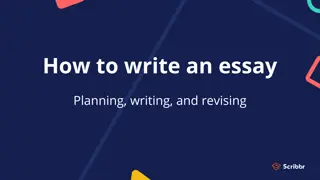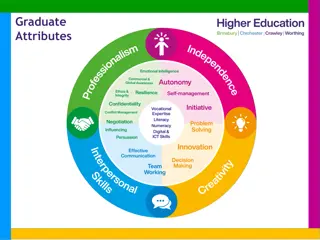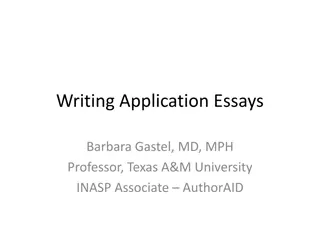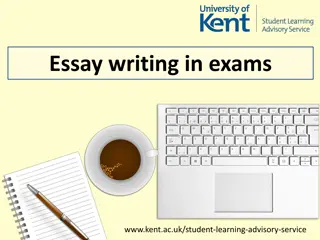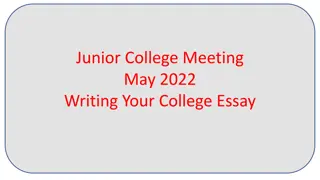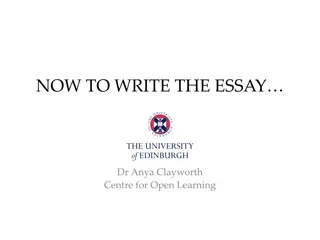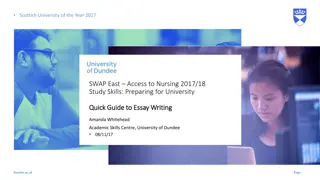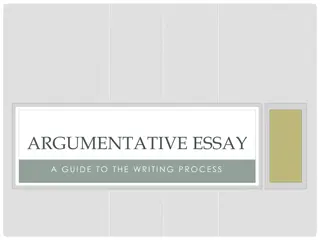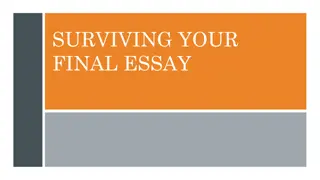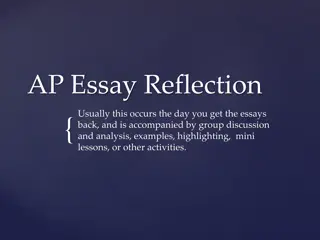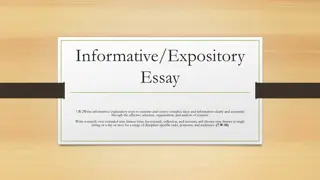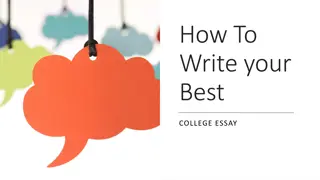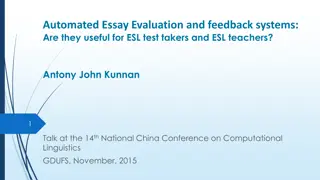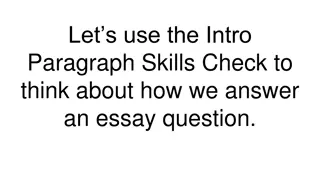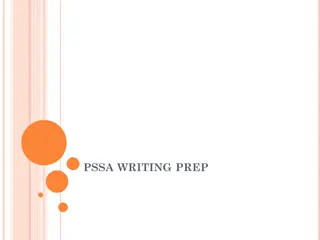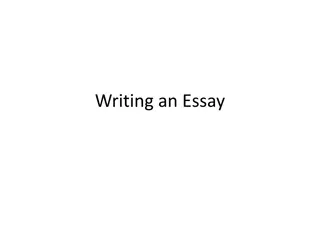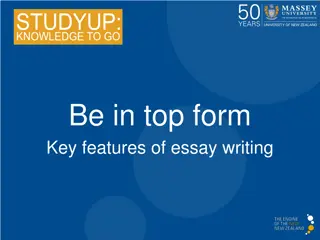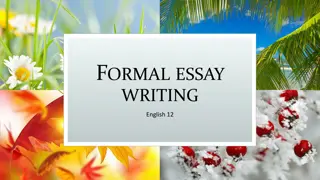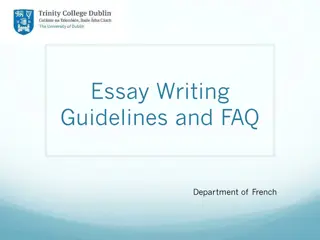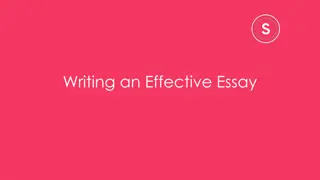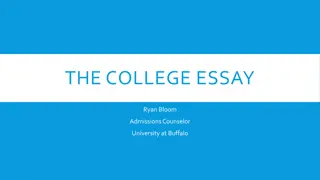Mastering the Art of Essay Writing
Discover essential tools and strategies for effective essay writing, including essay planners, alternative planning methods, understanding command words, structuring paragraphs, and more. Enhance your writing skills and communication abilities with practical advice and resources provided in this comprehensive toolkit.
Download Presentation

Please find below an Image/Link to download the presentation.
The content on the website is provided AS IS for your information and personal use only. It may not be sold, licensed, or shared on other websites without obtaining consent from the author.If you encounter any issues during the download, it is possible that the publisher has removed the file from their server.
You are allowed to download the files provided on this website for personal or commercial use, subject to the condition that they are used lawfully. All files are the property of their respective owners.
The content on the website is provided AS IS for your information and personal use only. It may not be sold, licensed, or shared on other websites without obtaining consent from the author.
E N D
Presentation Transcript
Essay Writing Toolkit Made by Mike Gershon mikegershon@hotmail.com
Contents Essay Planner Alternative Plans Command Words Paragraphs Orwell Russell Writing Guides Purpose Structure Introductions Conclusions Read Aloud Speed Debating Formal Debating Silent Debate Evaluation Tables First Sentences Peer-assessment Redrafting Model Answers Evidence Reasons Examples Group Essays Viewpoints Cut and Paste Repetition Mind Maps Critiquing Arguments Different Arguments Sources
Back to Contents Essay Planner An excellent essay planner is available at: http://www.readwritethink.org/files/r esources/interactives/essaymap/ This resource helps students map out their essay in advance. It breaks the process down into simple steps and provides a clear, visual overview. Essay maps can be printed, saved or shared once complete. Blank essay maps can be printed off if students do not have computer access (this feature is available from the first page of the link).
Back to Contents Alternative Plans A range of ways to plan essays: -Write a summary of your main argument. This is particularly helpful for clarifying and refining ideas. -Write the first sentence of each paragraph. These should answer the question and form a coherent whole. - Write the conclusion first. Then, work out what you will need to include in order to reach it. - Bullet point your introduction, main body, and conclusion. - Create a spider diagram with the essay question at the centre. -Draw out sub-questions from the title. Order the series of questions you create and answer each in turn. -Create a table. Put your key points across the top. Evidence for and evidence against goes along the side (for example - http://www.activehistory.co.uk/Miscellaneous/free_stuff/essay_planner/index. htm)
Back to Contents Command Words Command words are those words which indicate to a student what they ought to do in their essay. Evaluate Here are some examples: Explain Compare Contrast Describe Define Discuss Evaluate Explain Illustrate Justify Outline Describe Explanations of command words can be found at: www.wjec.co.uk/uploads/publications/10055.doc Students who know the functions of such words are in a better position to answer the question. http://store.aqa.org.uk/resourceZone/pdf/ict/AQA-ICT-W-TRB-CWICT.PDF http://seis.bris.ac.uk/~hihrp/StudySkills/EssayWriting.pdf http://owll.massey.ac.nz/academic-writing/command-words.php http://www.google.co.uk/url?q=http://hbsbusiness.net/commandwords.doc&sa=U&ei=5Gn LTpikBseu8QPzqdX-Dw&ved=0CBYQFjAAOAo&usg=AFQjCNFr9Gah16TOSsEki2a_M1Ia6EQzSQ
Back to Contents Paragraphs Paragraphs ought to have a clear focus. If the writer has a new point to make they should start a new paragraph. A long, unwieldy paragraph will most likely lack clarity. Remind students that an essay is a piece of communication. Good communication is clear and precise. Point Here are three examples of paragraph structures students can use in their essays: PEE Point (make a point) Explain (explain that point) Evidence (provide evidence to support the point) Explain PEEL As above with the addition of: Link (connect the paragraph to that which will follow) Evidence PESEL Point (make a point) Explain (explain that point) Support (support the point using evidence, reasoning or examples) Evaluate (evaluate the point) Link (connect the paragraph to that which will follow)
Back to Contents Orwell George Orwell wrote a wonderful essay railing against poor, imprecise and dishonest use of the English language. It is well worth reading and well worth passing on to your students. Rule 1 Rule 2 The essay contains six simple rules any writer can use to improve the accuracy and clarity of their work. Rule 4 Rule 3 The essay is available at: http://www.resort.com/~prime8/Orwell/patee.html Rule 5 Rule 6 http://wikilivres.info/wiki/Politics_and_the_English_Language http://www.netcharles.com/orwell/essays/politics-and-the- english-language.htm http://orwell.ru/library/essays/politics/english/e_polit http://mla.stanford.edu/Politics_&_English_language.pdf
Back to Contents Russell Bertrand Russell was best known as a philosopher, logician and social critic. He wrote clearly and with great lucidity. How Much of his work is available online: http://users.drew.edu/~jlenz/brtexts.html Perhaps the most useful piece for students is How I Write . This can be accessed at: I http://www.davemckay.co.uk/philosophy/russe ll/russell.php?name=how.i.write Write And In this document (paste into Word and enlarge the font size). It gives an insight into the process of writing and some simple rules one may wish to follow.
Back to Contents Writing Guides There are many guides to writing available. Some which come highly recommended are: The Element s of Style Fowler s Modern English Usage The Penguin Guide to Punctua -tion The Elements of Style, William Strunk JR. and E.B. White http://www.amazon.co.uk/Elements-Style-William-Strunk- Jr/dp/020530902X/ref=sr_1_1?ie=UTF8&qid=1321955875&sr=8-1 Pocket Fowler s Modern English Usage, Robert Allen (ed.) http://www.amazon.co.uk/Pocket-Fowlers-English-Paperback- Reference/dp/019923258X/ref=tag_dpp_lp_edpp_ttl_in The Penguin Guide to Punctuation, R.L. Trask http://www.amazon.co.uk/Penguin-Guide-Punctuation-Reference- Books/dp/0140513663/ref=sr_1_1?s=books&ie=UTF8&qid=1321956240&sr=1-1 (Advocacy, David Ross QC, contains an excellent chapter on legal writing. Nearly all of it is applicable to student essay writing. The book is available at: http://www.amazon.co.uk/Advocacy-David-Ross/dp/0521884764/ref=sr_1_3?s=books&ie=UTF8&qid=1321956381&sr=1-3)
Back to Contents Purpose An essay without a clear purpose is liable to become unfocussed. Coherence may be lost and, if it is, logic will most likely disappear as well. Here are some activities to help ensure students retain a clear purpose: Purpose i) Provide students with a range of essay titles. Ask them to come up with a single sentence for each which encapsulates what their answer would be about. ii) Set an essay for the class. Insist that the first sentence of each paragraph must answer the question. Once the essays are complete, ask students to read their first sentences to one another. Intention iii) Provide students with an essay title. Ask them to come up with a single sentence encapsulating what their answer would be about. Collect 3-4 different examples. Ask students to create an appropriate plan for each one. They should stick to the different purpose each time.
Back to Contents Structure Students think differently. Certain questions invite certain types of response. Here are a range of essay structures for students to use: 1) Introduction -> Arguments For -> Arguments Against -> Conclusion 2) Introduction -> 1st Argument For -> 1st Argument Against -> 2nd Argument For -> 2nd Argument Against -> Conclusion 3) Introduction -> Main Body -> Conclusion 4) Introduction -> First Key Theme -> Second Key Theme -> Third Key Theme -> Conclusion 5) Introduction -> First Point -> Critique of First Point -> Second Point -> Critique of Second Point -> Conclusion
Back to Contents Introductions Introductions should be clear and precise. They should indicate what the essay is about. They should answer the question. At times it may be appropriate to analyse certain words in the question and reformulate accordingly. An introduction should make it clear to the reader what to expect. It should be brief, saying only what is necessary and no more. Introduction 1 Introduction 2 Activities i) Give students a range of essay titles. Ask them to write introductions for each one. Introduction 3 Introduction 4 ii) Once students have written an introduction, ask them to rewrite it using fewer words but with the same meaning. iii) Put students in groups. Everyone has a piece of paper. Give an essay title. Everyone writes the first sentence of the introduction. Papers are then passed on and everyone writes the second line. Continue until the introductions are complete. Review and discuss. Introduction 5
Back to Contents Conclusions Conclusions should summarise what has gone before. They should never contain new material. That is, anything which has not been dealt with in the preceding text. A good conclusion draws together the threads which the writer has woven to form a tight, coherent whole. An average essay can be raised by a strong conclusion; a good essay can be felled by a bad one. Activities i) Give students a range of essay titles and ask them to write conclusions for each. When done, students work in pairs to compare and contrast. ii) Give students an essay title. Ask them to write their conclusion and then go back and write the essay. iii) Students are given an essay title. They must write 3-5 different conclusions which could fit with the title. Next, they compare these with a partner before planning out the detail which would precede a couple of the conclusions.
Back to Contents Read Aloud Reading ones own work out loud is a useful way to test the quality of an essay. Speaking what has been written means giving voice to anything which does not make sense, is not clear, or comes across as verbose. There is no where to hide when reading aloud. Activities i) Students complete an essay and get into groups. They take it in turns to read aloud to the rest of the group. Other members offer corrections and alternatives. ii) Students complete an essay. A few students take it in turns to read their essay aloud to the whole class. The audience makes notes and gives feedback (alternative: the audience is divided up and they make notes on different areas, for example structure, argument and so on). iii) Students complete an essay for homework. Once finished, they read it aloud to themselves (perhaps standing in front of the mirror). Any issues which appear in the reading should be corrected.
Back to Contents Speed Debating Speed Debating is a good activity to do in advance of essay writing. It works as follows: i) Introduce a proposition. For example, Conservatism is not relevant to modern politics . ii) Divide the class in half. For Against iii) Indicate which half of the class will be arguing FOR and which half will be arguing AGAINST. iv) Give students time to construct their arguments. v) Ask the students who are FOR to stand up. They must find a student who is AGAINST and sit opposite them. vi) Students take it in turns to speak (2-3 minutes for each) before 1-2 minutes of free-for-all. vii) Students who are FOR stand up and find a new partner. Repeat step VI and so on.
Back to Contents Formal Debating Formal Debating is a good activity to do in advance of essay writing. It works as follows: i) Introduce a motion. For example, This house believes that human behaviour is biologically determined . ii) Divide the class in half. One half will be FOR. One half will be Against. Proposer iii) Each group must nominate three speakers. These will be the Proposer, the Seconder, and the Summariser. iv) The groups prepare their arguments in detail. Seconder v) The Proposers, Seconders, and Summarisers are called forward. They sit at the front, with a judge in between. vi) The Proposer FOR the motion speaks first for an allotted period of time. The Proposer AGAINST then speaks and so on. Summariser vii) The rest of the class act as an audience. They must come up with questions to ask the speakers at the end of the debate. viii) Finally, a judgement is given as to who has won the debate. Resources available at - http://www.ltscotland.org.uk/debatinginschools/index.asp
Back to Contents Silent Debate Silent Debate is a good activity to do in advance of essay writing. It works as follows: i) The teacher writes questions and/or statements in the centre of 3-6 large pieces of paper. These are then spread around the room. ii) Students enter and are told they are not allowed to talk. They must take out a pen and move around the room, reading the questions/statements. iii) Students must write their responses to each question/statement on the paper. iv) When they have answered each one, they continue to move around, except they now comment on other people s comments. v) Once sufficient time has elapsed, end the activity and use the sheets as a basis for discussion. From this, it will be easy for students to dive straight into their essays.
Back to Contents Evaluation Tables Evaluation tables help students to critique the material . An example is given below. This is taken from A Level Psychology. The study could easily be replaced by an interpretation of a historical event, a philosophical argument, a scientific experiment and so on. Evaluation tables makes it easier for students to write about such information as they contain. This in turn makes their essays more critical. Study Strengths Weaknesses Bobo Doll study Control group used Potentially unethical Pre-screening for aggression; children sorted into groups containing similar mixtures of personalities May have shown behaviour imitative of adults rather than simply aggressive Findings corroborated by greater amount of male than female violence in society Sample lacked variation
Back to Contents First Sentences What comes first sets the tone. It must. In an essay, the first sentence of a paragraph ought to indicate what that paragraph is about. If it does not, there is a high risk of logical confusion developing. This makes the writing less clear. First Sentence The purpose of an essay is to communicate understanding, argument and judgement. Therefore, one should always strive for clarity and sense. From the first sentence, to the last. Activities i) Give students an essay title. Ask them to imagine how they would go about answering it. Then, they must write the first sentence of each paragraph. When finished, develop into paired or group discussion. ii) Students are in groups. Give them an essay title. Ask them to write the series of first sentences which would suffice for the essay. When finished, each group reads their sentences out and takes feedback. iii) Students are given an essay title. They come up with two alternate plans then write the first sentences for each. Students then self-assess, deciding which would be the better essay and why.
Back to Contents Peer-assessment Peer assessment affords students two opportunities. First, of reading someone else s work. Second, of analysing and applying the mark scheme they themselves will be assessed against. Activities i) Students are given a title and write their essays. On completion, they pair up and swap work. The teacher provides a mark scheme. Students mark each others work and set a target. Discussion ensues. ii) Students write their essays. The teacher collects and shuffles them. The essays are handed out at random, along with a mark scheme. Students mark the essay they get and set a target. They then seek out the author and explain their decisions. iii) Students write their essays anonymously. The teacher collects them in, shuffles them and redistributes them, along with a mark scheme. Students mark the essay they receive. Finally, authors reclaim their essays and discuss their results with the marker.
Back to Contents Redrafting Redrafting is not always the most pleasurable activity. Students often find it hard to write an essay and baulk at the prospect of redoing it. Nonetheless, redrafting is an effective medicine if one can get past the bitter taste. The following activities might make the process a little easier. 1st Activities i) Take in and mark your students essays. Set them a clear target which relates directly to what they have done in that essay. Give them one example of how they might alter their work. Return the essays and ask for a redraft based on the target, the identification of areas requiring improvement, and the example of what that improvement might look like. 2nd ii) Students write their essays and make a note at the bottom of what they would like an editor to focus on (for example, argument, grammar, key words and so on). Students swap essays and edit each others work paying special attention to what has been requested. The essays are returned and students use the editing to help them redraft their original piece. 3rd iii) Students receive a target, either from the teacher or via peer- assessment. They choose 2-3 paragraphs to redraft in line with the target. The original marker then looks at the new paragraphs and provides feedback.
Back to Contents Model Answers A model answer is the ideal; it is the perfect mix of content and style, evaluation and analysis, argument and evidence. Some exam boards provide model answers as exemplars. You can create your own library by photocopying the very best work your own students produce. Activities i) Following the writing and marking of an essay, provide students with a copy of the mark scheme. Place them in groups and ask them to create a model answer, taking account of the detailed information in the mark scheme. ii) Hand out copies of the model answers you have collected (without any grades visible). Give students the appropriate mark scheme. In pairs, they work through the model answer, identifying why it received such high marks. Follow up with discussion. iii) Students work in groups of 4-6. They should already have completed an essay. Using the same essay title, their marked essays and a mark scheme, they create a model answer on large sugar paper, splitting the work up between them. Students present to each other with explanations.
Back to Contents Evidence A wise man proportions his belief to the evidence (David Hume). A claim is a claim. Only through support does it become an argument. Evidence is one of the most crucial means of support. It picks out something in the world and says hey, look: this proves what I am saying to be true . Whether it actually proves it or not is another matter, one most often left to the reader to decide. These activities will help students think carefully about evidence: Activities i) Give students an essay title and ask them to write a brief plan. Next, ask them to go through and identify what evidence they would use to support each point. They should make a list of this evidence and provide a rationale for each piece. Students swap their plans and lists of evidence with a partner. They read through and comment on the strength of the evidence. Finally, a discussion ensues. ii) Introduce students to the credibility criteria: Bias; Corroboration; Consistency; Reputation; Ability to Perceive; Vested Interest; Expertise; Neutrality (BC CRAVEN). Provide them with a range of evidence to assess using these criteria. More information at http://en.wikibooks.org/wiki/A-level_Critical_Thinking iii) Students work in pairs. They are given a topic to discuss. Person A starts. They must support every point they make with evidence. Person B stops them if they fail to do this at any point and the roles are reversed.
Back to Contents Reasons We use reasons to persuade others that our claims are true. For example: Children can write essays (claim/conclusion) If A, 1) I have seen many children write essays. Then B 2) I myself was once a child and wrote many essays at that time. 3) Cognitive psychology shows intelligence is not innate and that everyone has the capacity to learn. Each of these is a reason supporting the claim (or conclusion). We could insert the word because between them to further prove the case. Here are some activities to get students thinking about reasons: If B, Then C Activities i) Give students a newspaper article or politician s speech and ask them to identify the claims made along with the reasons used to support them. If A, ii) Give students a claim (this could be subject-related or completely random). Ask them to come up with as many reasons as possible which could support it. Then C iii) Give students an essay title. Ask them to come up with a brief plan. For each key point identified in the plan, they must find three reasons which could be used to support it. Students then work in pairs, explaining their reasons to one another and critiquing them.
Back to Contents Examples When one makes a claim about the world, it is often general or abstract in nature. The addition of an example helps to contextualise the statement in the mind of the audience (whether reader, viewer or listener). This strengthens the case, adding a reference point which can be taken a hold of, considered, checked and reflected upon. Claim For example: Churchill provided effective leadership during the war. For example, he spoke eloquently to the British people, thus galvanising their spirits at a time of great difficulty. Example 1 Activities i) Students work in pairs. One person speaks, the other listens. The speaker must back up everything they say with an example. If they fail to do so, the listener points this out and the roles are reversed. Example 2 ii) Hand students their essays back. Ask them to go through and highlight every example they have given. Then, they should identify where else they could have used examples and what these could have been. iii) Give students an essay title. Ask them to plan the essay. Next, students identify an appropriate example for each paragraph in the main body.
Back to Contents Group Essays Like long-distance running, essay writing can be a lonely business. Inspire and motivate students by having them work in groups. Here are some possible activities: i) Put students in groups of three. Provide an essay title. Working together, the students must write the essay. One could do the introduction and first key point, one most of the main body, and the third the remainder including the conclusion. ii) Students work in pairs. They agree a central argument for the essay. They then agree the main points in favour of this argument. One student writes the paragraphs explaining these. The other student writes rebuttal paragraphs evaluating each point. iii) Students work in groups of three or four. They are given an essay title and a large sheet of sugar paper. They must produce a detailed plan on the sugar paper which they will subsequently present to the class. The audience quizzes the group on their decisions.
Back to Contents Viewpoints In a court case two different arguments will be proposed in the face of a single set of evidence. Instances are frequent where both cases are persuasive and plausible. It can take much careful reasoning to come to a decision as to the verdict which ought to be given. Students, eager to put forward their own viewpoints, sometimes miss the nuances inherent in many topics. These activities seek to draw out some of the gradations. Activities i) Give students a key piece of content (for example, a study, an historical event, a philosophical argument). Follow this up with a range of perspectives relevant to your subject. Ask students to analyse the content from each position in turn. They can then compare and contrast the results. ii) Students work in pairs. They receive an essay title. Each must sketch a plan which has a clear, coherent perspective. Students swap plans and write each other s essays. iii) Place an essay title on the board. Hand out, at random, a series of cards with different positions/perspectives written on each. Students must sketch a brief plan of the essay they would write from that perspective/position. They then stand up and find a partner (with a different perspective/position). Fevered debate should ensue, with the plan as a point of reference.
Back to Contents Cut and Paste This activity helps students to think about essay structure, logic and coherence. i) Make copies of three essays. These should represent a high middle and low mark (for example, A, C, and E). ii) Cut the essays up, using paragraph breaks as the points of incision, and place the pieces in an envelope (make sure you do not mix up pieces from the different essays). iii) Students get into groups. Each group receives an envelope. They empty out the contents and try to recreate the essay. Once they are done, they read through and assess its quality. iv) Repeat with the other two essays if time. v) Develop a whole-class discussion drawing on the experience.
Back to Contents Repetition The single best way to improve ones writing is through repetition. Practicing again and again. Students may not like this, but they will acknowledge the powerful logic which underpins it. Here are some choice quotes to help sugar the pill: First Attempt Second Attempt Practice is the best of all instructors (Publilius Syrus). Third Attempt My secret is practice (David Beckham). What we hope ever to do with ease we may learn first to do with diligence (Samuel Johnson). Fourth Attempt Diligence is the mother of good fortune, and idleness, its opposite, never brought a man to the goal of any of his best wishes (Miguel de Cervantes). Fifth Attempt Begin - to begin is half the work, let half still remain; again begin this, and thou wilt have finished (Marcus Aurelius). Sixth Attempt
Back to Contents Mind Maps Many people use mind maps to plan essays. A mind map has a central topic, out of which stem key ideas. From these key ideas, further branches develop, containing sub-points. Mind maps help one to order information visually. They are also useful for ticking off information as it has been dealt with. In this way they act as an aide memoire, as well as an organisational tool. Information on mind mapping can be found at: http://freemind.sourceforge.net/wiki/index.php/Main_Page http://www.mindtools.com/pages/article/newISS_01.htm http://www.thinkbuzan.com/uk/
Back to Contents Different Arguments We all have our own ways of thinking and areas of life to which we attach particular importance. For students, a corollary of this is that they can get stuck in a certain groove when writing their essays. The activities below may work as a corrective: Essay Title Argument 1 Activities i) Give students an essay title. Ask them to compile as many different arguments as possible which could be advanced in response. Argument 2 ii) Students get into groups and are provided with a range of essay titles. They choose one and create a large spider diagram (say, on sugar paper) covering as many answers as possible. Argument 3 iii) The teacher writes different perspectives, viewpoints or positions on a series of cards (for example, in sociology this could be Marxist, feminist, pluralist, functionalist, postmodernist, and social-constructivist). The cards are handed out at random along with an essay question. Students must develop their arguments from the perspective, position or viewpoint indicated on their card.
Back to Contents Critiquing Arguments Arguments are there to be critiqued. Most things can be rebutted. Little is irrefutable. An essay is more persuasive when taking account of this reality. Dogmatic browbeating wins few followers; it makes the proponent appear naive and simplistic. The following activities centre on critique of arguments: Activities i) Students write an essay. The teacher takes the work in and redistributes it. Students go through the essay they have been given with the express intention of challenging each argument they find. Challenges are noted with coloured pen. Students then get together and discuss their critiques. ii) Take a newspaper article, a comment piece, or an MPs speech. Give out to students. Ask them to work through the text and identify as many challenges to the argument as they can. This can include issues such as reliability, credibility, logic, accuracy, validity, the evidence called upon, the relationship between reasons and conclusion, and so on. iii) Use the issues noted above as lenses. Write them on separate pieces of card and hand them out at random. Students must look at an argument, piece of evidence or essay and produce a critique through their lens. These are then shared and used as a basis for discussion.
How I Write Bertrand Russell (from - http://www.davemckay.co.uk/philosophy/russell/russell.php?name=how.i.write) I cannot pretend to know how writing ought to be done, or what a wise critic would advise me to do with a view to improving my own writing. The most that I can do is to relate some things about my own attempts. Until I was twenty-one, I wished to write more or less in the style of John Stuart Mill. I liked the structure of his sentences and his manner of developing a subject. I had, however, already a different ideal, derived, I suppose, from mathematics. I wished to say everything in the smallest number of words in which it could be said clearly. Perhaps, I thought, one should imitate Baedeker rather than any more literary model. I would spend hours trying to find the shortest way of saying something without ambiguity, and to this aim I was willing to sacrifice all attempts at aesthetic excellence. At the age of twenty-one, however, I came under a new influence that of my future brother-in-law, Logan Pearsall Smith. He was at that time exclusively interested in style as opposed to matter. His gods were Flaubert and Walter Pater, and I was quite ready to believe that the way to learn how to write was to copy their technique. He gave me various simple rules, of which 1 remember only two: Put a comma every four words", and never use and except at the beginning of a sentence . His most emphatic advice was that one must always re-write. I conscientiously tried this, but found that my first draft was almost always better than my second. This discovery has saved me an immense amount of time. I do not, of course, apply it to the substance, but only to the form. When I discover an error of an important kind I re-write the whole. What I do not find is that I can improve a sentence when I am satisfied with what it means. Very gradually I have discovered ways of writing with a minimum of worry and anxiety. When I was young each fresh piece of serious work used to seem to me for a time-perhaps a long time-to be beyond my powers. I would fret myself into a nervous state from fear that it was never going to come right. I would make one unsatisfying attempt after another, and in the end have to discard them all. At last I found that such fumbling attempts were a waste of time. It appeared that after first contemplating a book on some subject, and after giving serious preliminary attention to it, I needed a period of sub-conscious incubation which could not be hurried and was if anything impeded by deliberate thinking. Sometimes I would find, after a time, that I had made a mistake, and that I could not write. the book I had had in mind. But often I was more fortunate. Having, by a time of very intense concentration, planted the problem in my sub-consciousness, it would germinate underground until, suddenly, the solution emerged with blinding clarity, so that it only remained to write down what had appeared as if in a revelation. The most curious example of this process, and the one which led me subsequently to rely upon it, occurred at the beginning of 1914. I had undertaken to give the Lowell Lectures at Boston, and had chosen as my subject Our Knowledge of the External World . Throughout 1913 I thought about this topic. In term time in my rooms at Cambridge, in vacations in a quiet inn on the upper reaches of the Thames, I concentrated with such intensity that I sometimes forgot to breath and emerged panting as from a trance. But all to no avail. To every theory that I could think of I could perceive fatal objections. At last, in despair, I went off to Rome for Christmas, hoping that a holiday would revive my flagging energy. I got back to Cambridge on the last day of 1913, and although my difficulties were still completely unresolved I arranged, because the remaining time was short, to dictate as best as I could to a stenographer. Next morning, as she came in at the door, I suddenly saw exactly what I had to say, and proceeded to dictate the whole book without a moment s hesitation. I do not want to convey an exaggerated impression. The book was very imperfect, and I now think that it contains serious errors. But it was the best that I could have done at that time, and a more leisurely method (within the time at my disposal) would almost certainly have produced something worse. Whatever may be true of other people, this is the right method for me. Flaubert and Pater, I have found, are best forgotten so far as I am concerned. Although what I now think about how to write is not so very different from what I thought at the age of eighteen, my development has not been by any means rectilinear. There was a time, in the first years of this century, when I had more florid and rhetorical ambitions. This was the time when I wrote The Free Man s Worship, a work of which I do not now think well. At that time I was steeped in Milton s prose, and his rolling periods reverberated through the caverns of my mind. I cannot say that I no longer admire them, but for me to imitate them involves a certain insincerity. In fact, all imitation is dangerous. Nothing could be better in style than the Prayer Book and the Authorized Version of the Bible, but they express a way of thinking and feeling which is different from that of our time. A style is not good unless it is an intimate and almost involuntary expression of the personality of the writer, and then only if the writer s personality is worth expressing. But although direct imitation is always to be deprecated, there is much to be gained by familiarity with good prose, especially in cultivating a sense for prose rhythm. There are some simple maxims-not perhaps quite so simple as those which my brother-in-law Logan Pearsall Smith offered me-which I think might be commanded to writers of expository prose. First: never use a long word if a short word will do. Second: if you want to make a statement with a great many qualifications, put some of the qualifications in separate sentences. Third: do not let the beginning of your sentence lead the reader to an expectation which is contradicted by the end. Take, say, such a sentence as the following, which might occur in a work on sociology: Human beings are completely exempt from undesirable behaviour-patterns only when certain prerequisites, not satisfied except in a small percentage of actual cases, have, through some fortuitous concourse of favourable circumstances, whether congenital or environmental, chanced to combine in producing an individual in whom many factors deviate from the norm in a socially advantageous manner . Let us see if we can translate this sentence into English. I suggest the following: All men are scoundrels, or at any rate almost all. The men who are not must have had unusual luck, both in their birth and in their upbringing. This is shorter and more intelligible, and says just the same thing. But I am afraid any professor who used the second sentence instead of the first would get the sack. This suggests a word of advice to such of my hearers as may happen to be professors. I am allowed to use plain English because everybody knows that I could use mathematical logic if I chose. Take the statement: Some people marry their deceased wives sisters . I can express this in language which only becomes intelligible after years of study, and this gives me freedom. I suggest to young professors that their first work should be written in a jargon only to be understood by the erudite few. With that behind them, they can ever after say what they have to say in a language understanded of the people . In these days, when our very lives are at the mercy of the professors, I cannot but think that they would deserve our gratitude if they adopted my advice.
Sources: My head Other people s heads http://studentzone.roehampton.ac.uk/howtostudy/academicwriting/unit5/index.html http://www.reading.ac.uk/internal/studyadvice/StudyResources/Essays/sta-planningessay.aspx http://www.readwritethink.org/files/resources/interactives/essaymap/ http://www.resort.com/~prime8/Orwell/patee.html http://wikilivres.info/wiki/Politics_and_the_English_Language http://www.netcharles.com/orwell/essays/politics-and-the-english-language.htm http://orwell.ru/library/essays/politics/english/e_polit http://mla.stanford.edu/Politics_&_English_language.pdf http://www.davemckay.co.uk/philosophy/russell/russell.php?name=how.i.write http://www.activehistory.co.uk/Miscellaneous/free_stuff/essay_planner/index.htm) www.wjec.co.uk/uploads/publications/10055.doc http://store.aqa.org.uk/resourceZone/pdf/ict/AQA-ICT-W-TRB-CWICT.PDF http://seis.bris.ac.uk/~hihrp/StudySkills/EssayWriting.pdf http://owll.massey.ac.nz/academic-writing/command-words.php http://www.ltscotland.org.uk/debatinginschools/index.asp http://freemind.sourceforge.net/wiki/index.php/Main_Page http://www.mindtools.com/pages/article/newISS_01.htm http://www.thinkbuzan.com/uk/ http://www.samueljohnson.com/diligenc.html http://quotationsbook.com/quotes/tag/diligence/ http://quotationsbook.com/quote/43073/ http://thinkexist.com/quotation/practice_is_the_best_of_all/192267.html http://www.brainyquote.com/quotes/authors/m/marcus_aurelius.html http://www.brainyquote.com/quotes/authors/d/david_hume.html http://en.wikibooks.org/wiki/A-level_Critical_Thinking http://www.criticalthinking.org.uk/unit2/fundamentals/elementsofarguments/reasons/ Back to Contents


